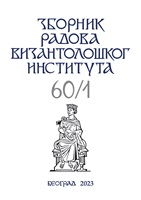KOMPLEXÜBERSETZEN AM KAISERHOF IN KONSTANTINOPEL: DIE GRIECHISCH-LATEINISCHEN KAISERVERTRÄGE MIT VENEDIG AUS SPÄTBYZANTINISCHER ZEIT
COMPLEX TRANSLATIONS AT THE IMPERIAL COURT IN CONSTANTINOPLE: THE GRAECO-LATIN IMPERIAL TREATIES WITH VENICE FROM THE LATE BYZANTINE PERIOD
Author(s): Christian GastgeberSubject(s): Cultural history, Political history, Social history, 13th to 14th Centuries, 15th Century, Translation Studies
Published by: Vizantološki institut SANU
Keywords: Byzantine diplomacy; Venice; Byzantine documents; bilingual texts; Latin – Greek;
Summary/Abstract: Among the documents of the Byzantine emperor’s chancery, the treaties with Byzantium’s Italian ally, Venice, provide rich material for studying the process of creating a bilingual document. In general, Byzantine documents addressing the Latin West were increasingly influenced by Latin chancery features and adopted them. The most striking example is the switch from Greek-Latin to Latin in letters to Western addressees. The alliance treaties with Venice, the majority of which, starting from the 13th c., have survived in original form, allow us to analyse the complex translation process based on several sources: the treaty stipulations in the final version after the negotiations of the responsible delegates of both parties and any items repeated from former treaties, modified for the new version but containing at least some phrases and technical terms. The formatting of the document in two columns (Greek on the left, Latin on the right) suggests that the Greek version was the first and the Latin was created on this basis, but more often than not, the modified items represent updates demanded by the Latin party and reflect the instructions and prepared wording from the government in Venice. A linguistic analysis reveals that some treaties, or at least parts of them, were translated from the Venetians’ Latin version into the emperor’s Greek version. Several factors determine whether a version represents the source text or the translation. By examining examples where the Latin text served as the source for the Greek version, we can further our understanding of imperial chancery’s Latin proficiency. Some treaties also confronted the Byzantine emperor with the Latin practice of issuing documents confirmed by an imperial notary. Occasionally, even the Byzantine emperor adopted this practice but failed to be consistent. As a result of this approach to the linguistic question of bilingual treaties, it is no longer justified to generalize that they were originally written in Greek and then translated into Latin.
Journal: Зборник радова Византолошког института
- Issue Year: 2023
- Issue No: 60/1
- Page Range: 175-217
- Page Count: 43
- Language: German

